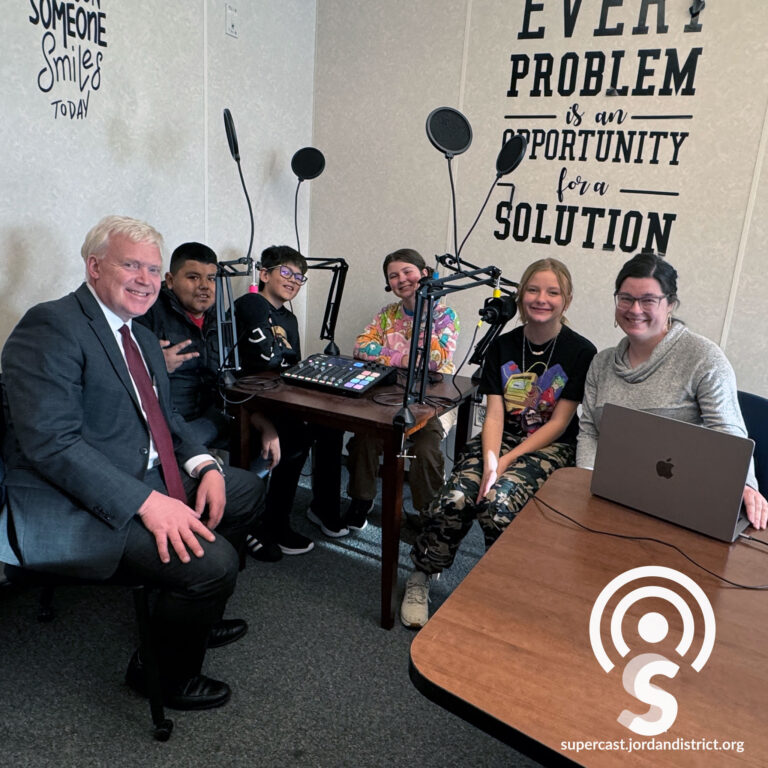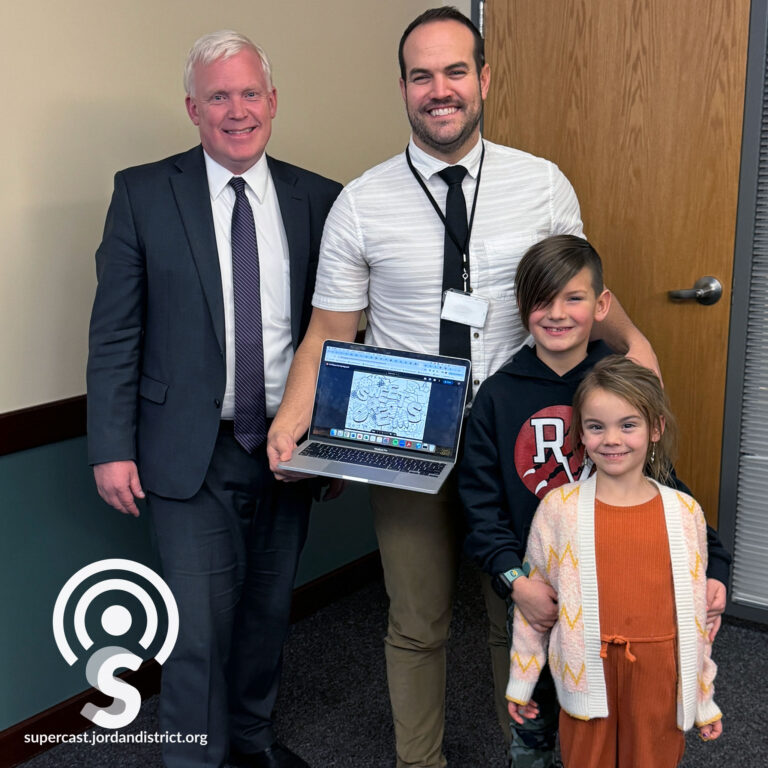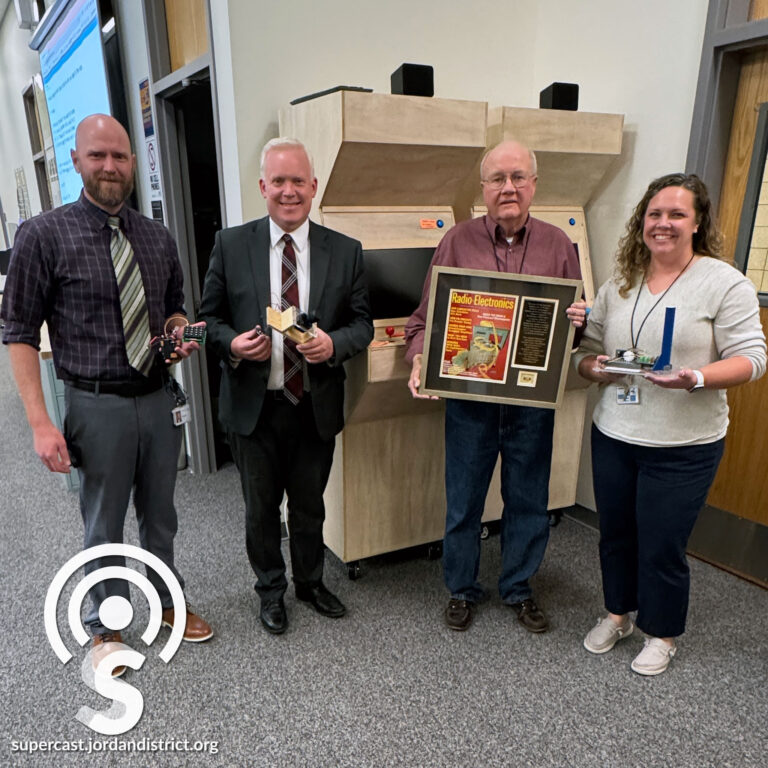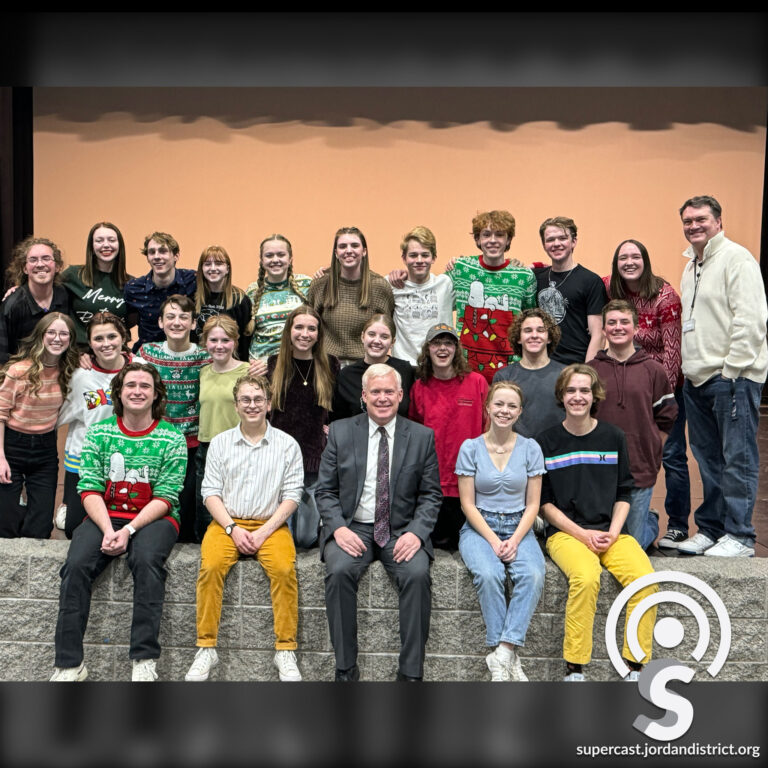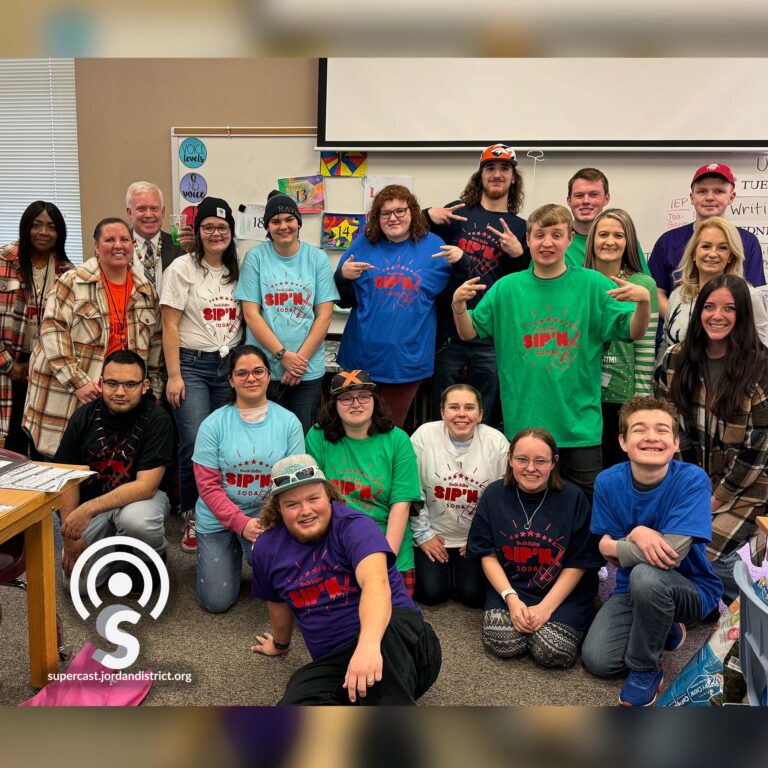They are elementary school students who simply love storytelling and getting in front of the microphone to share their stories with anyone willing to listen.
On this episode of the Supercast, we head to Falcon Ridge Elementary School where a student produced podcast called the Junior Falcon’s is giving everyone involved opportunities to tell stories in a way that is fun and educational, fostering new skills they can take into a future careers.
Find out what happens when we show up to do a podcast, on the Junior Falcon’s podcast.
Audio Transcription
[Music]Anthony Godfrey:
Hello and welcome to the Supercast. I'm your host, Superintendent Anthony Godfrey. They are elementary school students who simply love storytelling and getting in front of the microphone to share their stories with everyone who will listen.
On this episode of the Supercast, we head to Falcon Ridge Elementary School where a student-produced podcast called The Junior Falcons is giving everyone involved the opportunity to tell stories in a way that is fun and educational, fostering new skills that they can take into future careers.
Find out what happens when we show up to record a podcast during the Junior Falcons podcast.
We're at Falcon Ridge talking with Principal Theresa Christensen. I'm about to go on your student podcast.
Theresa Christensen:
Yes, we're excited.
Antony Godfrey:
Tell me about the podcast.
Theresa Christensen:
Well, so it started three years ago. We had some students that were outside doing interviews on the playground and they wanted to do a podcast and came and said, "Can we do a podcast?" And I had no idea how to do it. Went to a training in St. George and they said, "Just do it." So I bought an old mic and we just started a podcast. So we've actually grown from there and it's been something we've done every year with our fifth and sixth grade students.
Anthony Godfrey:
So it began as an underground unauthorized podcast.
Theresa Christensen:
Yes, yes it was.
And it grew into a fully endorsed podcast.
Theresa Christensen:
Yes, one where we can control a little bit more of what's happening.
Anthony Godfrey:
And what were the interviews about?
Theresa Christensen:
They were interviewing other students, asking what they were doing. I said, "Let's take this on a grander scale." And they started interviewing faculty. They've gone out and interviewed people in the community, things that they're fascinated about. They've had a couple of podcasts where they've had discussions over movies they've wanted to see or they did a poll about what kind of a lunchtime should we have? Should we have recess first? So it's really something that's grown from what the students want to talk about.
Anthony Godfrey:
I'm trying to remember whether we had a podcast at my elementary in the 70s. No, I don't think we did.
Theresa Christensen:
I didn't have one in mine either.
Anthony Godfrey:
No, it's really exciting and it's a great way for them to engage with other students, faculty members, and to have their voice be heard.
Theresa Christensen:
And do research. They've researched things out and they search for things to share in the community.
Anthony Godfrey:
Now how do students get the opportunity to be part of the podcast crew?
Theresa Christensen:
So in the beginning it was a group of boys that came to me. So that first year I said, "Hey, let's do it," and brought them in. And then the next year they wanted to really continue the podcast. They'd moved on to seventh grade and so we did interviews and we had applications come in. They did interviews with us and basically, they conducted a podcast of us and did interview questions. We kind of based it off of their ability to ask questions, to carry a conversation, and do research. So this year these four students are the ones that were chosen to be our podcast team.
Anthony Godfrey:
Is it pretty competitive?
Theresa Christensen:
Yeah, actually it was. It was really, it's really hard to narrow it down when you've got so many good candidates. Ashlin is the only one that was on last year as a fifth grader and she's on this year as a sixth grader and then the other three are all new.
Anthony Godfrey:
Tell me how frequently does the podcast get posted?
Theresa Christensen:
We try to do it once a week, but you know obviously with breaks and things in there, but we at least have two or three podcasts a month.
Anthony Godfrey:
That's awesome. That's frequent. I know personally that that takes a lot of work.
Theresa Christensen:
It does. And it's a lot of work on the kids part as well because they're the ones that have to come up with a podcast every single week and who are they going to interview and questions and that type of thing. So they've been awesome about it.
Anthony Godfrey:
Do you think I'm in for some tough questions?
Theresa Christensen:
I think you are in for some tough questions.
Anthony Godfrey:
Okay, I'm as ready as I'll ever be I guess.
Theresa Christensen:
Okay.
Anthony Godfrey:
Okay, awesome.
Mariah Stout:
Soundcheck just to make sure that our mics are on.
Anthony Godfrey:
Okay. Am I in the right spot?
Mariah Stout:
Yep, go ahead and just start whatever you want to say.
Anthony Godfrey:
Care Bear, Care Bear, Care Bear.
Mariah Stout:
Perfect. So we're good to go. You guys already figured out who's doing your intro, who's doing your outro?
Kambri:
Yeah, so Ashlin's doing intro, he's doing outro.
Mariah Stout:
Okay, and Alex has got our outro. Fantastic. Okay, and we know the order where we're doing our quick intro, introducing ourselves and then going around the circle. Perfect. You guys ready? Three, two,
Ashlin:
Welcome, Junior Falcons. Today we are, we will be interviewing our superintendent, Mr. Godfrey. Let's get into it then. So Mr. Godfrey, how long have you been being a superintendent?
Anthony Godfrey:
This is my fifth year as superintendent. I started in 2019.
We're talking now with the Junior Falcon podcasters who just put me through an excellent interview. Introduce yourselves and just say what grade you're in.
Evodio:
My name is Evodio, I'm in fifth grade.
Alex:
Alex and I'm in fifth grade.
Kambri:
My name is Kambri and I'm in fifth grade.
Ashlin:
My name is Ashlin and I'm in sixth grade.
Anthony Godfrey:
All right, we've got fifth and sixth graders here. I'm so impressed. You guys have a great setup here and you have great chemistry. You're able to play off of each other and kind of signal to each other and keep the flow of the podcast going. And I think we've been doing it. This is my fifth year podcasting but the school's been doing a podcast for about three years now and I think it's super cool that you guys do this. Tell me what made you want to be a part of this podcast. I know there's a whole tryout and everything. Tell me what made you want to be a part of the podcast.
Ashlin:
So what made me want to be a part of the podcast is I'm a huge talker. I love talking and I like to get to know people and that's pretty much it. I wanted to get to know like people in younger grades than me but not at the time. But now I get to know people in younger grades than me like these people, lovely people.
Alex:
I kind of came here for the same reason Ashlin did because I love talking and I just wanted to meet some new people. But another reason is because my parents thought it would be a good idea since when I get home I don't really do anything. So it's kind of like just an after-school thing for me to do but I love it and I'm kind of glad I did sign up and made it onto the team.
Anthony Godfrey:
Great.
Kambri:
I wanted to be on podcasts because I am a huge talker like they both said. But I also have like the kind of personality where you are curious about random things and you ask the randomest questions but not everyone has the answer to. But it's cool finding people that do have the answer too.
Anthony Godfrey:
Great.
Evodio:
The reason I joined podcast is because I was in a joint student council but they already empty other spots. That's why I joined podcast.
Anthony Godfrey:
So you thought 'well, student council is full I'm going with the podcast.' Okay great. What do you love most about being able to be on a podcast here at your elementary school?
Ashlin:
What I love about being on a podcast at my own elementary school- woah, I'm almost sang the ABCs- is like I don't know, I kind of want to have a podcast when I'm older and just like talk about stuff random topics that I'm curious about and this is where I can kind of start it and maybe carry it on.
Anthony Godfrey:
So this is maybe the start of something even bigger down the road.
Kambri:
So what I like most about podcast is probably when we get to have new people come in that I've never met before and I just have a lot of questions and you can kind of think of your own stuff rather than having someone really tell you what to do, and that's a really big part for me.
Anthony Godfrey:
Great because the conversation kind of flows naturally and you're able to just ask questions as they come.
Alex:
Yeah I really joined because I just I wanted to meet new people and make some new friends but it was also because I also kind of thought that maybe if I did this I could start my own podcast and maybe make it a little bit bigger.
Evodio:
I like podcast because I get to know new people like them and some kids in my class.
Anthony Godfrey:
So not just meeting the people that you get to make the podcast with but also the people that you get to interview.
Students:
Yeah.
Anthony Godfrey:
Is it easier to talk to people now that you've been talking to people all year for the podcast? Is it easier to walk up and talk to people that you don't know?
Ashlin:
Well, I think it's easier sitting down and having a podcast because then you're like face to face like talking and you can ask them questions that you normally wouldn't ask about them when you just randomly walk up to them. So yeah.
Anthony Godfrey:
So it gives you an excuse to talk to new people.
Ashlin:
Yeah.
Alex:
It makes it so they can’t run away.
Ashlin:
That's true.
Anthony Godfrey:
What have you learned from being part of the podcast?
Alex:
I learned about conversation threads and how if you give just one idea for a conversation that conversation won't last that long. So you want to give more parts of the conversation, more like ideas for them to talk about with the conversation.
Anthony Godfrey:
Well, you did that with me and you did a great job of it.
Evodio:
My friend here stole all my ideas I was going to say.
Anthony Godfrey:
I know that does happen.
Kambri:
It's like thinking of new questions or questions to ask on this box. I wasn't here last week to plan. So I think it gives me like I can be more creative and go like out of the box that I'm usually in and like find different things to ask and follow-up questions are huge on our podcast.
Anthony Godfrey:
I like that. A good follow-up question is as important as an initial question sometimes even more so. But what is one of your favorite interviews?
Ashlin:
This was kind of a long time ago. I'm not really sure but I don't know if we were interviewing anybody. I think we were just like starting the podcast and there was this kid named Cole and there's this one episode that he opened the door to leave and it made this huge creaking sound and the mics picked it up and it was so funny. We all just like laughed. That's like one of my favorites.
Anthony Godfrey:
Did that make it a scary episode?
Ashlin:
No, it wasn't scary.
Anthony Godfrey:
It wasn’t like this creepy creak.
Ashlin:
He was trying to open it slow so it wouldn't make a noise but we found out opening it faster would not let it not make a noise.
Anthony Godfrey:
Science- you learn things. It's those unexpected moments it sounds like that have been really fun. How about for you?
Alex:
My favorite episode wasn't that long ago but was when we interviewed one of the newer teachers to the school. Her name was Mrs. Sarah and she just had a lot of really funny things to say and we talked about her dog. And she was a huge Swiftie, so we talked about that and just some of the things she was doing in her class.
Anthony Godfrey:
Great so you got to know a new teacher and her dog.
Evodio:
Mine is this one. I get to talk to you.
Anthony Godfrey:
I was hoping that one of you would say this was your favorite. Thank you for backing me up. Now this has been a blast for me to get to talk with each of you and you're naturals. You are all so good at this so whatever ambition you have beyond this I'm sure you're going to be successful at it. I love the idea that you just want to get to know other people through the podcast. That's really it. If you're curious about other people that's that's where you're successful as a podcaster I think.
Kambri:
I also think it like makes you step out of your comfort zone if you're not one that like really likes to talk to other people but you like to talk. It gives like it makes you step out of your comfort zone trying something new.
Anthony Godfrey:
You guys are awesome. I'm so impressed and thank you very much for having me on your podcast. It's an honor. If people want to listen to your podcast which I'm sure they do after hearing this one, where do they go? How do they find your podcast?
Ashlin:
So you can go on Spotify and just type up the Junior Falcons podcast.
Anthony Godfrey:
Okay.
Ashlin:
Falcon Ridge Junior Falcons podcast. But you can just look up there and you can either search for each season. So you can either go to one of our older seasons or this season which is a newer season. Newest season.
Alex:
I'm just saying while you're there you should just like follow us on Spotify. You should.
Anthony Godfrey:
So don't just listen. Follow.
Alex:
You're so close. You're already playing it. You can just hit it one more time.
Anthony Godfrey:
Hit that follow button. Be part of the community.
Alex:
And you get you can get notified when we post our new episodes.
Anthony Godfrey:
You're all fantastic. I'm so impressed. And if I ever need a co-host I have a deep bench right here. All right. Thanks. Thanks a lot for spending time with me. I appreciate you staying after school and talking with me. Good luck with the podcast going forward and you've got at least one new listener. That's me.
Stay with us when we come back. We talk with the advisor for the Junior Falcons podcast.
Break:
Hello, I'm Sandy Riesgraf, Director of Communications for Jordan School District, and we want to invite you to connect with us. So many exciting things are happening in your child's school, your neighbor's school, in every school here, every day. Don't miss out on following the fun or simply staying informed when there's important information we need to share. Join us at jordandistrict.org, or follow us on Facebook, Twitter, and Instagram @jordandistrict. We can't wait to connect.
Anthony Godfrey:
We're talking now with Mariah Stout, one of the fourth-grade teachers here at Falcon Ridge and the podcast advisor. Thanks for giving us this opportunity.
Mariah Stout:
Yeah. Oh, thank you we're super excited to have this to talk with you and the kids were super excited. We're so glad that we were able to be on your podcast.
Anthony Godfrey:
Well, I loved being on theirs. They're very impressive. Tell me about the progress they've made since they first auditioned and were chosen.
Mariah Stout:
So huge gains. So what's cool is that when they first come do their podcast tryout, you see them one on one. What's interesting is then from there they get put into groups and then they play off of each other. It's interesting because you'll get kids- they pair up and they're like, “Oh, I don't really know you very well”. So at first, when you listen at the very beginning, you can hear there's a little bit of awkwardness because it's just everybody's trying to feel each other out. But then from there, we kind of talk about what were some good things that happened and things that they hear that “Oh, yeah, we can work on that.”
But also we look at different examples of other podcasts. And even some videos of like how to have a conversation. It's great because, as you know, it's like Alex talked about conversational threads. So one of the videos that we watched about how to have a conversation and even encouraging them like, “Hey, go practice with your friends, go practice with family.” And they've made huge gains.
You probably noticed that some of them were pointing at each other like, ‘Oh, hey, I'm gonna ask the next question’. Because we’ve had a group that's like, ‘Oh, we don't want to talk over each other. So that's what we're going to do so that we don't.’ So it's it's been great, because I don't tell them explicitly what to do. They're the ones who come up with that. Or if there's something where I'm like, “Oh, yeah, that's something that we can work on.” We'll talk about it, we'll see videos, we'll practice with each other. Then the next time they're able to apply it, and it's awesome.
Anthony Godfrey:
They really do seem to have a great relationship and they're respectful of each other, like, “Oh, I want you to have a chance. Let's make sure they have a chance.” So I think they each have their voice, and they're able to balance things out. There are just so many skills that they're obviously developing as part of putting this podcast together. Skills that will serve them for a long time to come.
Mariah Stout:
Yeah, indeed. And the best part is, especially when you hear from the beginning to where they are now, getting them to listen to understand. Instead of just like, “Oh, I'm asking this question. And then I'm just going to move on to the next thing without actually listening.” And so getting it to where, especially where we've hit up on like, “Hey, make sure you're having follow-up questions to show that you're actually listening”. That's been fantastic, just getting their listening skills, not just their hearing skills, but their listening skills to be able to help with that communication.
Anthony Godfrey:
I could tell that they had been really intentional about focusing on asking good follow-up questions, because there was a great flow to that interview with them. I hated when you gave the signal that it needed to wrap up because I was having so much fun with it. They did such a great job.
Mariah Stout:
I know, I was sad too. I was like, “Oh, man, do we have to stop? This is fantastic.”
Anthony Godfrey:
Yeah, they're a lot of fun and they just light up when they're talking with each other. It's really cool to see and I can't thank you enough for providing such a rich learning experience for these kids after school.
Mariah Stout:
You're welcome. I love it. This is probably my favorite thing to do, is this podcast. I didn't think when I first started doing it, I was like, “I don't know how to do a podcast. Like I've listened to podcasts. That's the only thing I've got.” As we've been going like it's just been so much fun, especially just to see the growth that these kids have learning how to communicate with each other. And again, like all of their ideas are their ideas. I don't tell them who to interview or anything. They come up with who they want to interview. Or if they don't have someone they want to interview or like a topic they want to talk about. They come up with that on their own and I'll listen in and usually I'll just provide like, “hey, did you think about this? Or did you think about that?” Usually I just pose guiding questions, but they're the ones who come up with all of it.
Anthony Godfrey:
Sure. No, it's very meaningful for them to have that level of choice and what they do and their brains are firing like nothing else when they're coming up with these ideas and these questions I'm sure. What's the audience for this podcast? Do you have a lot of students that are listening?
Mariah Stout:
Yeah, I think so. Usually they'll have teachers that will play it. It's kind of sad because it's one computer showing so it just says one audience. But like, I mean, we've got classes of like– at least I know fifth grade and sixth grade show them or at least try to play it every week. So that's like 30 kids per class right there. So that's a lot of listens.
Anthony Godfrey:
So it's really aimed at students and teachers are listening as well. And I'm sure parents are listening also.
Mariah Stout:
Yeah, we'll have like, so far 20. It's pretty small. But like every year I've noticed that it's gotten bigger and bigger the longer that we've been doing it. So I'm hoping it continues to grow. Hopefully, eventually the whole community will be listening because it's their students that are running this.
Anthony Godfrey:
Yeah, no, I think it's awesome. Well, thank you for the great work you're doing with them. Tthis was a real real thrill.
Mariah Stout:
Oh, well, thank you for coming and talking about this. This has been really fun. Thank you.
Anthony Godfrey:
Thanks for joining us on another episode of the Supercast. Remember, education is the most important thing you'll do today. We'll see you out there.

